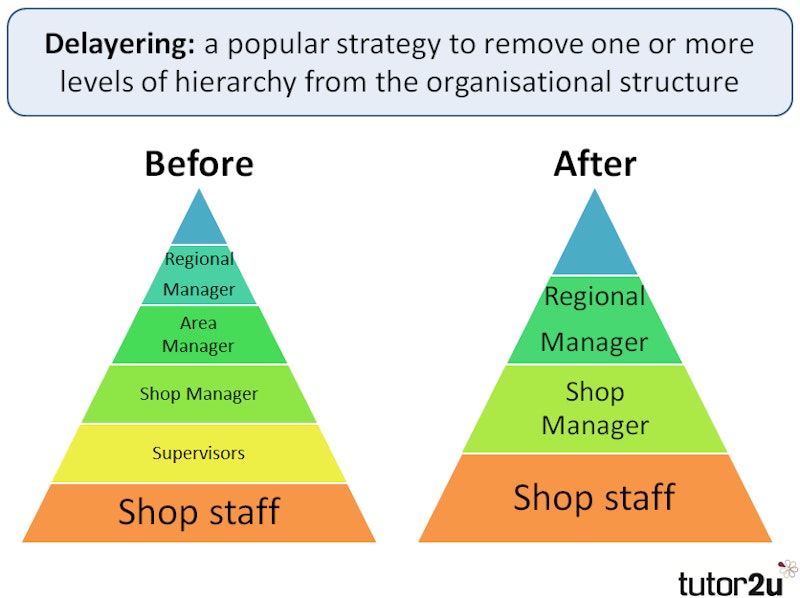Study Notes
Delayering
- Level:
- AS, A-Level
- Board:
- AQA, Edexcel, OCR, IB
Last updated 22 Mar 2021
The traditional way to achieve a flatter organisational structure is through delayering.

Delayering involves removing one or more levels of hierarchy from the organisational structure.
Frequently, the layers removed are those containing middle managers. For example, many high-street banks no longer have a manager in each of their branches, preferring to appoint a manager to oversee a number of branches. Some schools adopt this policy too – with a director of studies looking after several schools in a local area.
Delayering does not necessarily involve cutting jobs and overheads. But it does usually mean increasing the average span of control of senior managers within the business. This can, in effect, chop the number of layers without removing a single name from the payroll, as the people affected are moved elsewhere in the business.
However, it is fair to say that, increasingly delayering is seen as a way of reducing operating costs, particularly as a response to the economic downturn.
Delayering can offer a number of advantages to business:
- It offers opportunities for better delegation, empowerment and motivation as the number of managers is reduced and more authority passed down the hierarchy
- It can improve communication within the business as messages have to pass through fewer levels of hierarchy
- It can remove departmental rivalry if department heads are removed and the workforce is organised more in teams
- It can reduce costs as fewer (expensive) managers are required
- It can encourage innovation
- It brings managers into closer contact with the business’ customers – which should (in theory) result in better customer service
But disadvantages exist too, making a decision to delayer less clear cut:
- Not all organisations are suited to flatter organisational structures - mass production industries with low-skilled employees may not adapt easily
- Delayering can have a negative impact on motivation due to job losses, especially if it is really just an excuse for redundancies
- A period of disruption may occur as people take on new responsibilities and fulfil new roles
- Those managers remaining will have a wider span of control which, if it is too wide, can damage communication within the business. There is also a danger of increasing the workload of the remaining managers beyond that which is reasonable.
- Delayering may create skills shortages within the business – a danger is that delayering means that the business loses managers and staff with valuable experience
Any programme of delayering needs to be carefully thought-through. Get it wrong, and the damage to a business can be significant.
You might also like
Organisation charts
Study Notes
Hierarchy
Study Notes
Organisation: Departments in a Business (GCSE)
Study Notes

Can Retrenchment Save BHS?
4th March 2016